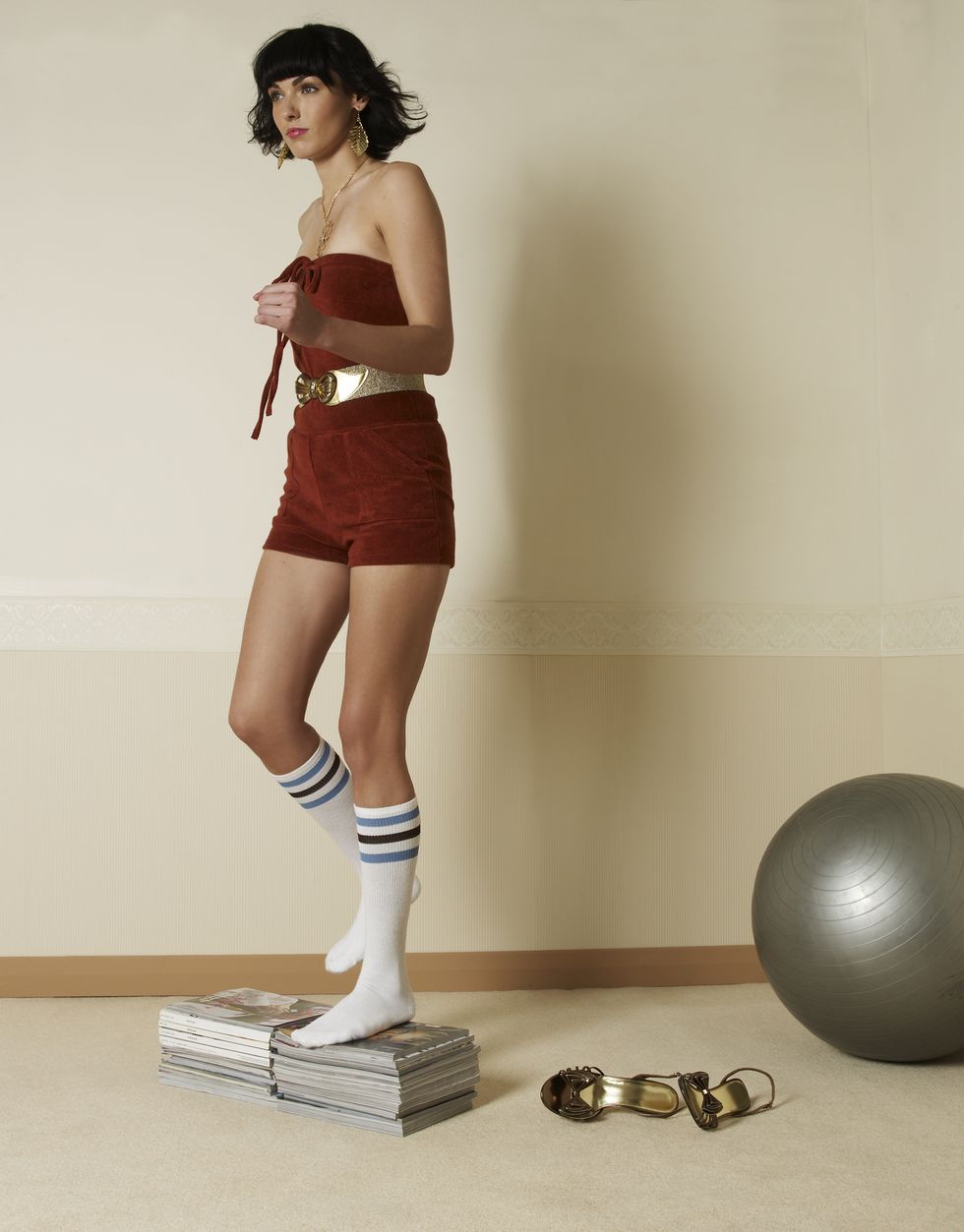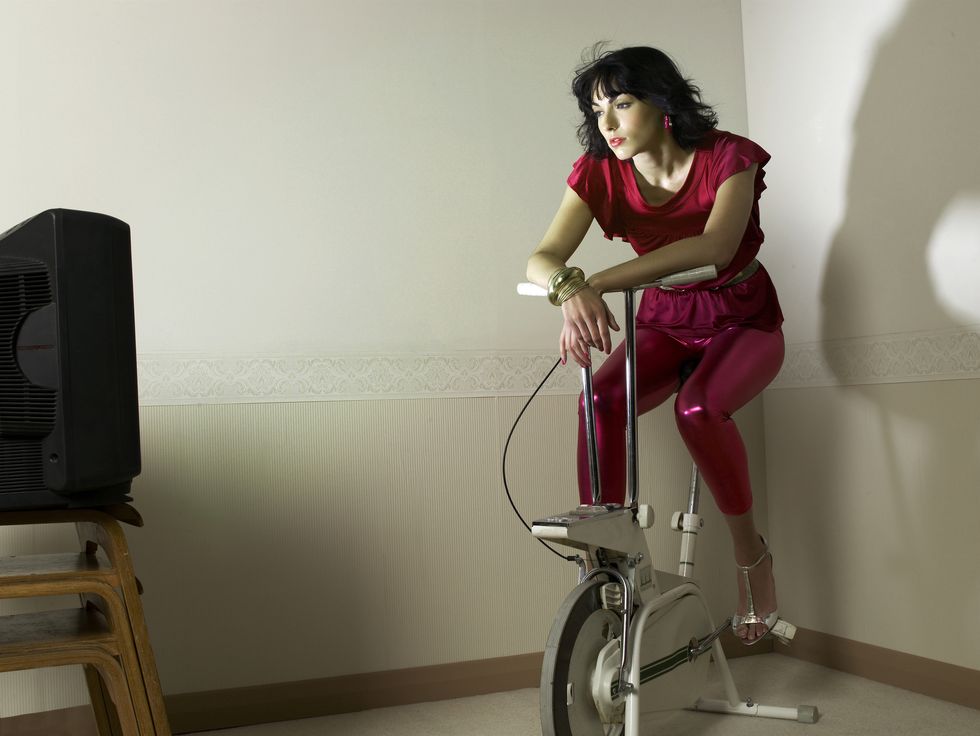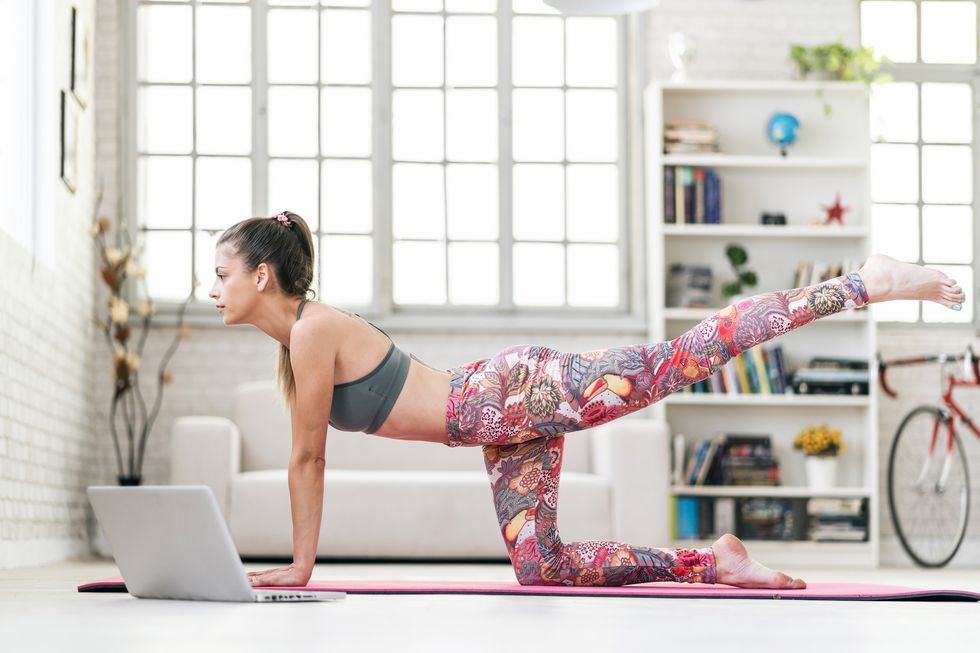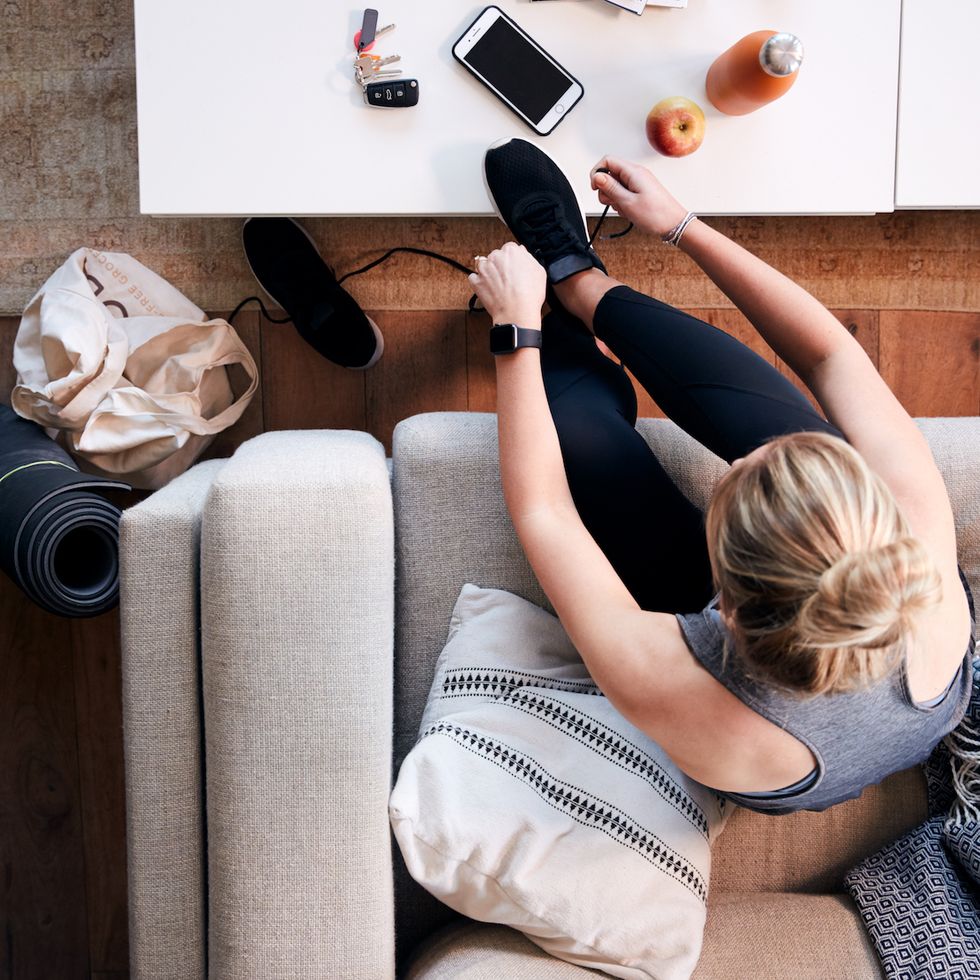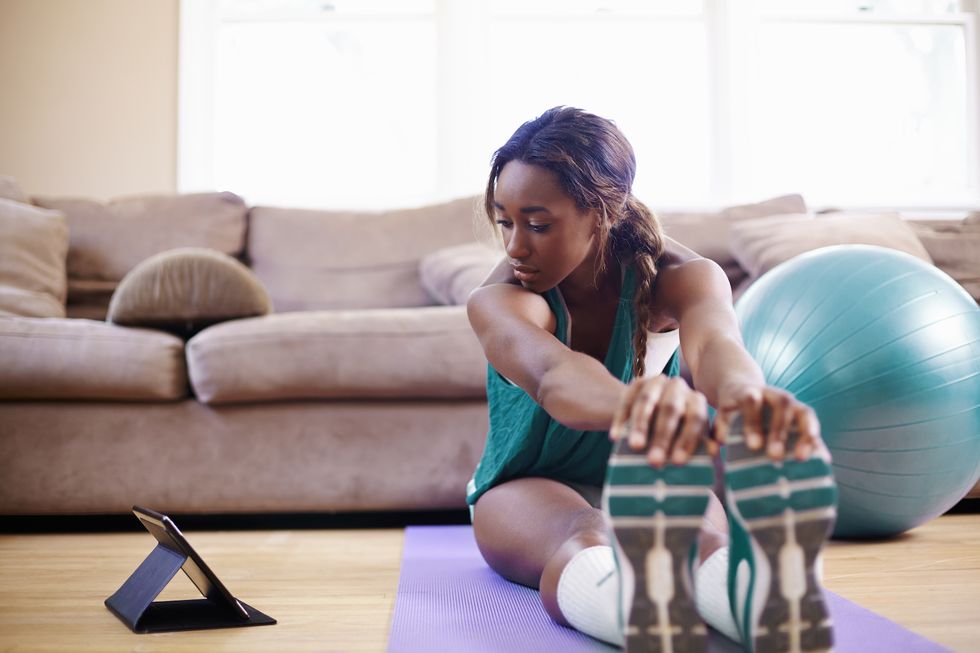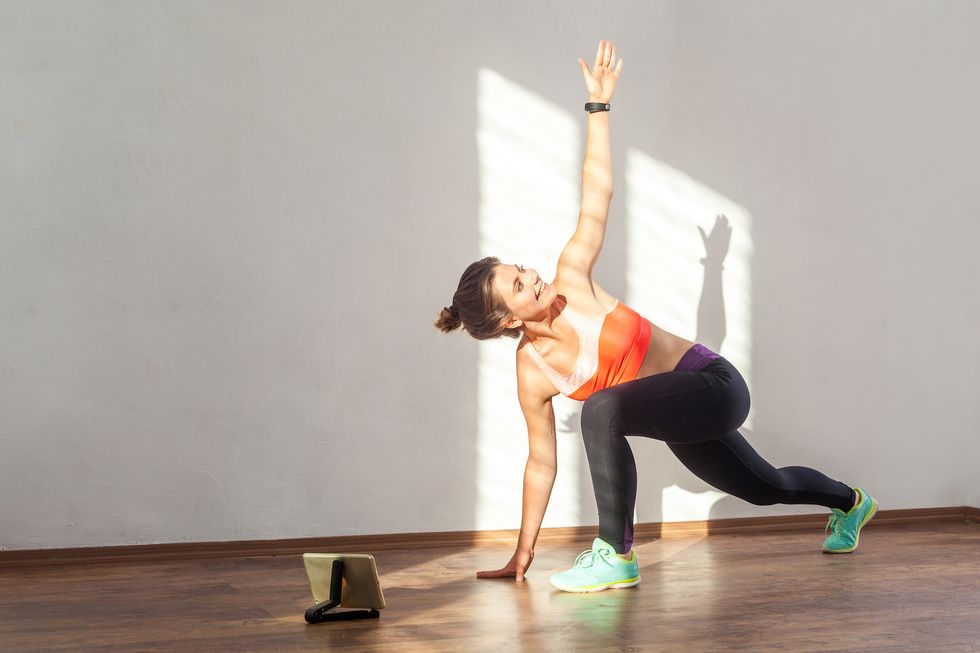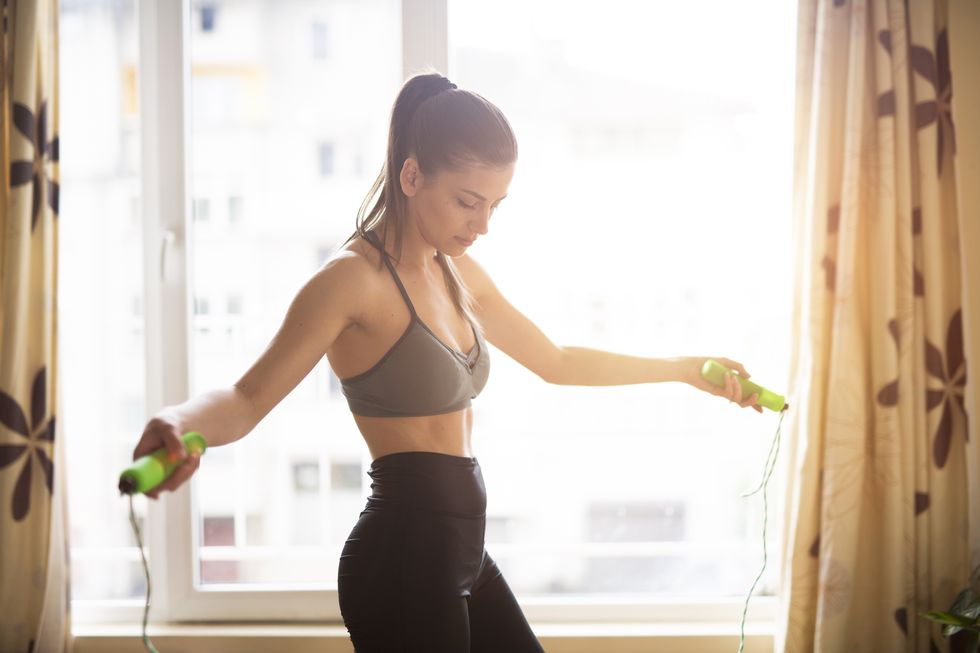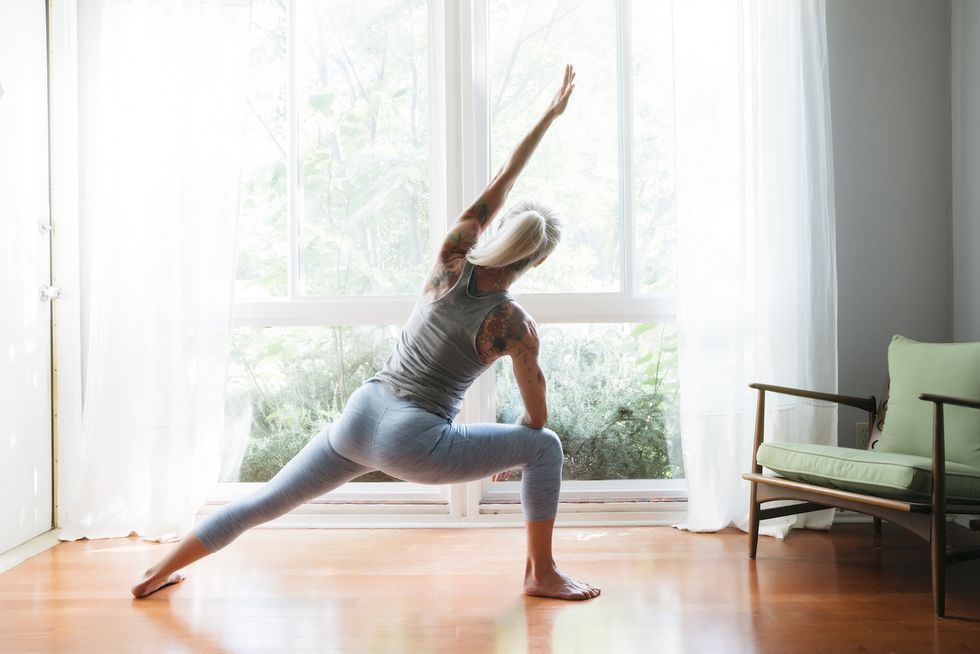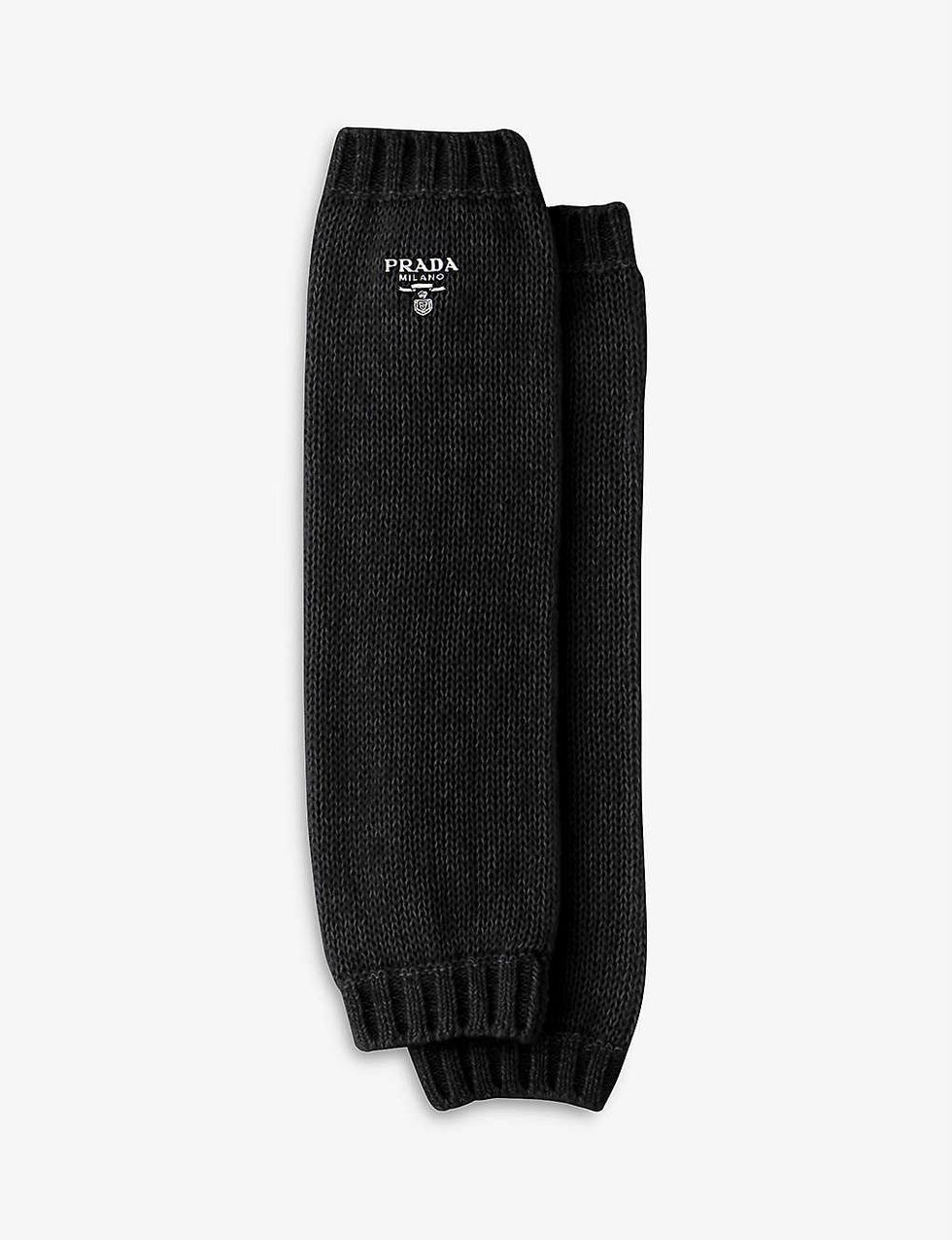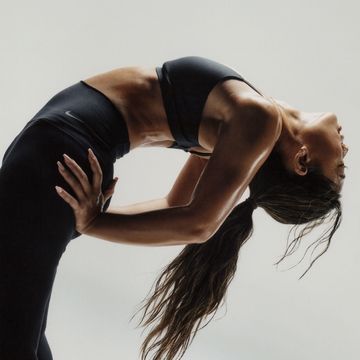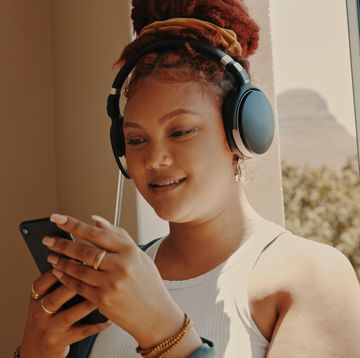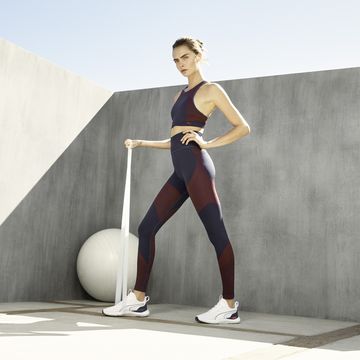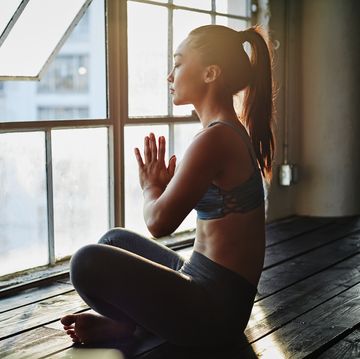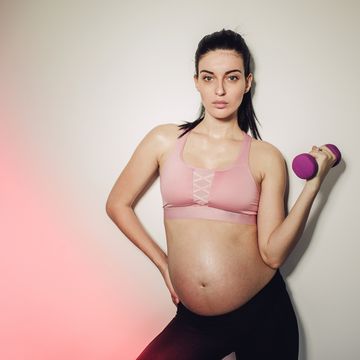As the response to the spread of coronavirus (Covid-19) ramps up in the UK, the public will now be social distancing from the confines of their own homes for at least three weeks, making the ability to do a home workout a high priority.
On Monday March 23, UK prime minister Boris Johnson addressed the nation and outlined strict new measures to tackle the pandemic.
From now on, people may only leave home to exercise once a day, to travel to and from work where ‘absolutely necessary’, to shop for essential items, and to fulfil any medical or care needs.
According to Johnson, for those wanting to head outdoors to exercise, they are able to do so once a day for a run, walk, or cycle. ‘This should be done alone or only with people you live with,’ he added.
So, for those of us who aren't into running and don't own a bike, it's time to figure out how to do circuit training, TRX, HIIT and more, in the living room.
From downloading fitness apps such as Centr and FIIT, to practicing live-streamed yoga classes and using items around the house to act as weights and resistance, there are plenty of ways to get fit at home.
But are in the home workouts as effect as those you can do at the gym?
‘Of course, modern gyms are full of equipment specifically designed for you to exercise hard, so the upper threshold will always be higher, but it is absolutely possible to work hard at home too, if you’re smart about how you use the environment,’ Luke Worthington, personal trainer and Nike trainer tells us.
We spoke to some fitness experts to find out everything you need to know about swapping trips to the gym for home workouts in the lounge.
Are home workouts as effective as going to the gym?
Gym-goers around the world will undoubtedly be craving some time on a cross-trainer, treadmill or in front of a set of dumbbells right now, as we enter a time of ‘lock down’ in the UK.
But according to Worthington, it’s important to understand that our fitness goals and ability to work out don’t need to change just because we’re now indoors.
‘A general fitness workout week should consist of resistance training two to three times per week, and cardiovascular training twice per week (one of which should be low intensity steady state, and the other higher intensity "stop start" style),’ he explains. ‘Now that gyms are closed, those priorities shouldn’t change.’
However, when asking whether home workouts are as ‘effective’ as those at the gym, personal trainer and bestselling author Alice Liveing points out that first, it’s important to define what we mean by ‘effective’ in order to understand our goals.
‘That is, what is your desired outcome of exercising?’ she asks. ‘Perhaps it’s just keeping fit and healthy, perhaps it’s mood boosting, maintaining weight or working towards fat loss.’
To maintain cardiovascular activity, Worthington notes that above all, you just need to move your body to elevate your heart, whether that’s with a walk, jog and bike ride – as is permitted under the government’s new instructions – or walking up and down the stairs.
‘Replicating the resistance training outside of the gym requires the most thought and so is often the one most neglected,’ he says, adding that resistance helps improve everything from hormonal health, bone density and mobility to reducing risk of injury and managing back pain.
As a result, he says it’s more important that ever to make the effort to implement resistance training into our fitness routines, now that gyms are closed.
Of course, a drawback of home training is that ‘you might not be able to life as heavy loads as you would do on the gym floor’, Liveing says, noting that ‘an increase in strength may be more challenging’.
‘Consistent body weight or resistance training from home can still help you to maintain strength, quality of movement, aerobic capacity and skill acquisition just as effectively as heading to the gym.’
Sophie Jones, an online certified personal trainer, notes that walking and running are still forms of bodyweight exercise, 'which are still just as effective outside, if not more effective than using machine to give you momentum'.
What bodyweight exercises are just as good as using gym equipment?
When it comes to working out at home, Worthington says that the most important bit to remember is to cover the human movements of ‘push, pull, squat, hinge and lunge’.
Sounds doable in the lounge, right?
Here are his top tips to achieving these movements at home:
Push
'The classic push up is a surprisingly advanced movement to do well. But you can regress this by placing your hands on a chair or stool to effectively bring the floor closer to you. Or, if you’re advanced, you can progress it by putting your feet on the chair to take the floor further away. Perform 3 sets of 8-10 reps.'
Pull
'This is the one often missed in home workouts as it's the hardest to perform without equipment. The simplest way I have found with clients is to improvise a TRX is by looping a bath towel around the top corner of a door and using this as an anchor point to perform a row. Perform 4 sets of 8-10 reps.'
Squat
'An easy one to replicate as we do this every time we stand up from a chair. For a beginner, we can simply do this by sitting and standing from a dining chair without using our hands. For the more advanced, take the chair away and hold any form of load in front of you. Perform 3 sets of 6-8 reps.'
Hinge
'This is the term we fitness folk use to describe any form of a deadlift. But what we mean is bending down to lift a heavy object from the floor. While barbells and dumbbells are designed for this you can really use any object at home. Perform 4 sets of 8-10 reps.'
Lunge
'We use this term to describe anything on one leg so a split squat (sometimes called a “static lunge”) is a good place to start. Before progressing on to reserve lunges, lunge forward and eventually lateral (sideways). Perform 3 sets of 8-10 on each leg.'
Which home workouts burn the most calories?
As many gym-goers know, exercising is not just about burning calories, but depends entirely on your fitness goals, whether that’s to gain muscle mass, build strength and stretch muscles, or recover from injury and lose weight.
However, when it comes to calories, Worthington explains that you will burn more calories through engaging more muscle mass, and by working harder.
‘So a home workout that covers all movements in one session is your best bet… how hard you then work is up to you!’ he says.
Liveing notes that high intensity interval training (HIIT) is great for burning calories as it uses ‘short sharp bursts of explosive movements such as squat jumps and burpees’.
Jones points out that when it comes to calorie burning, it all depends on the duration and intensity of the workout.
'You could work out for an hour but not burn many calories if the workout is not very demanding, or complete a really intense workout for only 15 minutes and burn the same amount, if not more,' she says.
'If calorie expenditure is your main worry, it’s also important to remember you don’t just burn calories though exercise alone.'
The trainer explains that prolonged periods of time at home might result in people expending less energy than normal, missing out on day-to-day activities like walking, shopping or standing on the tube.
'It’s a good idea to try to be aware of this – make the effort to get up and move around, walk around your house whilst on the phone or do some housework. It all adds to your overall NEAT (non energy activity thermogenesis),' she says.
What everyday items can you use as weights, resistance bands, support etc?
Gyms might have treadmills, TRX machines, static bikes, steppers and skipping ropes but in reality, you don’t need much to achieve the same fitness goals at home.
In fact, now might be the perfect time to find items that double up as workout equipment.
‘Towels make an excellent substitute for a TRX suspension trainer that you see in most gyms,’ says Worthington. ‘All you need to do is close a door over the short edge of the towel and grip the loose end like a TRX handle.’
Of course, when doing this, make sure you choose a door that closes towards you rather than away from you to avoid injury.
He also lists heavy objects such as potatoes and rice to add ‘external load’ as useful items.
Liveing, meanwhile, suggests filling up two water bottles to act as ‘dumbbells’ or using cans of baked beans for extra weight.
‘If you’re struggling for a mat, a couple of towels layered on top of each other can provide enough support for floor exercises, and try using a chair for exercises like step ups, squats and push ups,’ she says.
As a flight attendant, Jones knows all too well the need to adapt a workout depending on the equipment available and the practicality of your surroundings.
She says: 'You can include a chair, bench or your sofa to help support your workout and keep it varied. For example, use your sofa to perform tricep dips or Bulgarian split squats. My travel exercise kit is only three items – a thin yoga towel for grip, a small resistance band for leg and glute activation and a skipping rope.'
What should you be careful of when working out at home?
Navigating the space around a TV stand, sofa, bed and corner cabinets with pointy edges is tricky business.
However, above all things, it’s important to create a safe space when working out at home.
‘Wooden floors are slippery, and although we can use that to our advantage when adapting some exercises - it can be dangerous for others, so make sure you're wearing appropriate footwear,’ warns Worthington.
‘Similarly whatever objects you pick up and use for external load should be safe and secure – packs of flour and glass bottles don’t do so well when dropped!’
Balance is also a key element to working out at home. For example, while ‘push exercises’ might be easy enough to replicate at home, ‘pulls’ aren’t as much so take time to plan everything you want to do carefully.
In addition, Worthington advises fitness lovers to watch out for non-reputable media online.
‘Now, more than ever, Instagram is flooded with workout #inspo. However, take care to ensure you’re taking advice from experienced professionals,’ he says.
Jones agrees, adding: 'Ensure the workout you are doing is suitable for your level of fitness, so if you’re new to exercise follow a beginner workout or if you’re really unsure, seek some professional guidance.'
Liveing notes that while it might be tempting to throw yourself into a quick HIIT session at lunchtime or straight away after sitting down for eight hours straight at your desk, warming up is still an important part of training.
‘You still need to warm up, so don’t be fooled by thinking that because you’re at home you won’t need to,’ she says. ‘Even five minutes of raising your core temperature and mobilising can help to avoid injury and help you get the most from your workout.’
What is your top exercise for working out your arms, glutes, legs and core:
Arms
‘Get the Anniston arms from a lying tricep extension,’ says Worthington. ‘Lie on your back, arms out in front of you holding a two litre bottle of water in each hand. Bend the arms at the elbow keeping the upper arm still. Straighten the arm again squeezing the muscles on the back of your arms. Repeat for 3 sets of 12 reps.’
Alternatively, Liveing suggests perfecting your push ups. ‘Aim for 3-4 sets of around 5 reps.’
Glutes
‘Frog pumps are the strangely named answer to a no gym glute problem,’ says Worthington.
‘Lay flat on your back with the soles of your feet together as if you are saying your prayers with your feet. Your knees are bent and pointing outwards in a ‘butterfly’ position.
‘Press your feet into the floor to lift your hips up to the ceiling, pressing your knees out as you do so. you should feel a strong contraction in both glutei as you do so. Repeat for 4 sets of 20 reps.’
Legs
Worthington notes: ‘The classic squat has always, and will always be the ultimate leg exercise. You can perform this bodyweight, or hold something in front of you (tip: if you hold the object further away from you this doubles up as a core exercise).
‘Place you feet a little wider than hip width, weight distributed evenly. Tuck your pelvis underneath you by squeezing your buttocks and your abdominals. Take a deep breath in, and actively flex your hips to pull yourself down into a squat position, maintaining the brace around your midsection. Drive the feet into the floor to come back to standing. Perform 3 sets of 6-8 reps. If a regular squat is too taxing then practise simply sitting and standing from the sofa without using your arms to help.’
Core
‘Deadbugs look simple, are simple, but done correctly are a challenge for anyone,’ he says.
‘Laying flat on your back on the floor or a matt, try to get as much of your spine in contact with the ground surface as you can, think about making a double chin, and lifting up your belt buckle.
‘Raise your arms straight up towards the ceiling, and make a 90 degree bend at the hips and knees to create a ‘table top’ with your shins. Without any part of your spine losing contact with the floor, reach your left arm up above your head and extend right left leg.
‘Push your heel away, and pull your toes back towards you as you extend, imagine you are standing on that leg. Without allowing your heel to touch the floor, slowly return back to the set-up position.'
For those who like working on their core with plants, Liveing suggests aiming to achieve four sets of 10 reps of plank saws, moving your body weight back and forth with your elbows planted firmly to the ground at a 90 degree angle from your shoulders.
What exercises can you do to keep fit if you can’t go out running?
For those of us who enjoy a jog around the local park or marathon training, social distancing and self-isolating during Covid-19 will prove as much of a strain on the body as it does on the mind.
However, while the government advises people to continue running outside under certain measures, it is possible to do cardiovascular training in other ways at home.
‘Running would typically form one of your cardiovascular training sessions,’ says Worthington. ‘So from a physical benefits perspective you can replace this with anything that gets your heart rate and breathing rate elevated.’
His tip?
‘Pick an activity you enjoy so you’re far more likely to be consistent with it,’ he notes. ‘Whether its star jumps, running on the spot, or practising your favourite dance moves now no one can see you - this part of your training you can be pretty creative!’
Meanwhile, Liveing suggests doing a form of HIIT to fill the void of getting outside and running.
‘It will still help to improve aerobic capacity and overall fitness levels, but involves explosive bursts of movement rather than continuous running,’ she explains.
Jones advises people to consider getting creative and reworking traditional workout formulas.
'Tabata, if performed correctly, is very intense and aims to increase your heart rate and maintain it with just minimal rest periods. I'd suggest doing a range of exercises, 20 secs on with a 10 second rest for eight rounds,' she says.
She also suggests practising AMRAP (as many rounds as possible), EMOM (every minute on the minute) and partner workouts to stay motivated.
How often and at what time of day should we be exercising?
If you’re currently sat at home and kicking yourself for not exercising at the crack of dawn this morning or are counting down the hours until your post-work workout, then there’s no need to worry as the experts agree that there isn’t a ‘best’ time to train in reality.
‘Perhaps you feel most motivated first thing, or you might want to leave it until the evening after a long day at your laptop,’ notes Liveing. ‘As long as you’re doing something, it doesn’t matter when.’
When it comes to frequency, there’s no real need to change how often you work out because you can’t get to the gym.
According to Worthington, a general fitness programme usually features a combination of resistance training 3 times per week, and cardiovascular training twice per week on separate days.
‘As a rough guide I’d suggest that four to five days of some kind of movement, whether that’s weight training, yoga or running is a good amount to aim for,’ notes Liveing.
Now that many of us are working out at home, with some having to balance new work commitments and childcare, Worthington says it’s crucial – form a psychological perspective – to plan your weekly workout schedule on a Sunday night and stick to it as best you can.
‘This should include all of your working from home habits, start and finish time, mealtimes planned breaks - as well as your exercise,’ he says.
Liveing agrees, adding that it’s crucial to vary up your posture to alleviate back pain when sitting at a desk all day long.
‘As well as scheduling your work plan, also schedule in times to move between positions - so go from working at the kitchen table, to the sofa, even to the floor - but do change it up every couple of hours,’ she notes.
Jones adds: 'In our current situation we should try to make the most of this time to focus on ourselves. Try to use what would be our commuting and social time for some personal attention?
'By scheduling regular daily activities, from working out, to yoga or meditating we can build a positive structure into our day. It would be so nice to think that you may even find something positive to take away from all this, and some new healthy habits that improve your life when everything returns to normal.'
Like this article? Sign up to our newsletter to get more articles like this delivered straight to your inbox.
In need of more inspiration, thoughtful journalism and at-home beauty tips? Subscribe to ELLE's print magazine now and pay just £6 for 6 issues. SUBSCRIBE HERE

Katie O'Malley is the Site Director on ELLE UK. On a daily basis you’ll find Katie managing all digital workflow, editing site, video and newsletter content, liaising with commercial and sales teams on new partnerships and deals (eg Nike, Tiffany & Co., Cartier etc), implementing new digital strategies and compiling in-depth data traffic, SEO and ecomm reports. In addition to appearing on the radio and on TV, as well as interviewing everyone from Oprah Winfrey to Rishi Sunak PM, Katie enjoys writing about lifestyle, culture, wellness, fitness, fashion, and more.

